Last updated: December 2024
Need a little refresher? Here are some rules of the road that are often misunderstood.
There’s a lot to remember when you first learn to drive and a lot to keep in mind as the years roll on. Some rules are crystal clear, some are more complex, and others just fade over time.
Here are six road rules drivers are often confused by, have never really known, or have simply forgotten how to apply.
Driving into a blocked intersection
Drivers sometimes break this rule during heavy congestion to avoid getting stuck at a set of traffic lights for too long.
But if the intersection or the road ahead that you’re trying to enter is blocked, you should not enter or attempt to cross until it’s clear. You need to wait until it’s completely clear of traffic or other blockages, even where there are no hatched yellow markings across the intersection (regulation 111 of the Road Traffic Code 2000 WA).
If the blockage doesn’t clear in time, you risk being trapped in the path of oncoming traffic.
In addition to being a collision risk, queuing across a blocked intersection can worsen congestion and delays.
Always wait until it’s safe and clear to go, rather than edging forward and anticipating traffic will move in time.
Motorists queuing at lights or intersections should also ensure they do not stop their car so that it blocks a side street (regulation 143) unless it’s to comply with another regulation, avoid a collision or it’s an emergency.
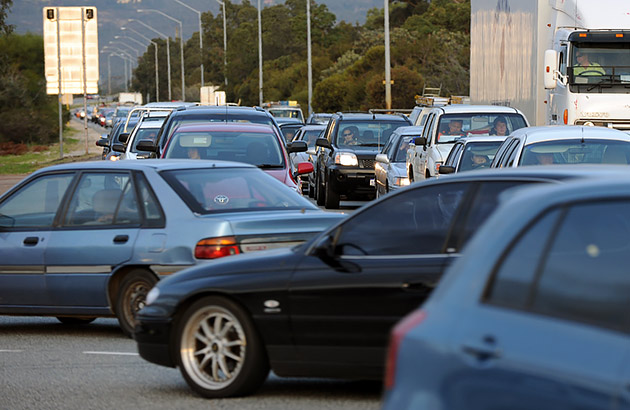
RELATED:
WA road rules you may not know about »
RELATED: Things you may have wrong about speeding and speed limits »
Turning right at traffic lights with no arrow
At traffic lights, where there’s no dedicated right-turn arrow, drivers must make several decisions, including whether to enter the intersection and whether there’s a suitable gap to enable a safe turn.
According to regulations 44 and 45, when the green light facing you is lit and there are no signs or signals stating that turning right is prohibited, you are allowed to enter the intersection and turn right. But as with the rule above, you should not enter the intersection if it is blocked with traffic.
Once you’re in the intersection, before you make your turn, you need to give way to oncoming traffic travelling straight or turning left (except if they’re turning left at a slip lane), and only cross when there’s a safe gap in the traffic. You must also give way to any pedestrian crossing the road you’re entering.
If you’ve stopped having fully entered the intersection and the light changes to yellow or red, you must leave the intersection as soon as you can do so safely. This means you don’t need to rush across in front of traffic to make your turn before the light changes to red - wait until it’s safe to complete your turn, even if this means you need to finish crossing on a red signal.
Keeping left
The ‘keep left’ rule is one that often confuses drivers, so here’s the definitive answer according to the Code, regulation 113.
On multi-lane roads, where there’s more than one lane for vehicles travelling in the same direction, if the speed limit is under 90km/h you only have to keep left where there is a sign saying, ‘keep left unless overtaking’, otherwise you can drive in any lane.
On multi-lane roads where the speed limit is 90km/h or more, you do need to keep left, including on freeways.
There are, however, some exceptions.
If the limit is 90km/h or more and/or there is a ‘keep left unless overtaking sign’, you don’t have to keep left if:
- you’re turning right or making a U-turn;
- you’re overtaking;
- the left lane is a special purpose lane, e.g. bus lane, slow vehicle turnout lane;
- the left lane is a turning lane and you’re not turning left;
- you’re avoiding an obstruction;
- you’re required to drive in a particular lane by appropriate signage (i.e. particular kinds of vehicles such as trucks);
- the other lanes going in the same direction are congested with traffic.
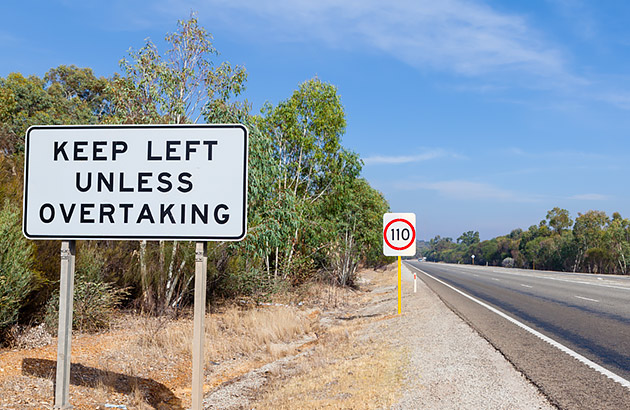
Crossing white dividing lines
According to regulation 116, where there’s a single solid line, a single solid line on the left of a broken line, or two solid lines together, you must stay on the left of the line.
There are exceptions such as when making a right turn or a U-turn (where permitted), when keeping a safe distance to pass a bicycle or eRideable (regulation 124A) and when you need to avoid an obstruction (regulation 120). Where there’s a single broken line or a broken line to the left of a single solid line, you may cross the dividing lines to overtake another vehicle, provided the right side of the road is clear of traffic and it’s safe to do so.
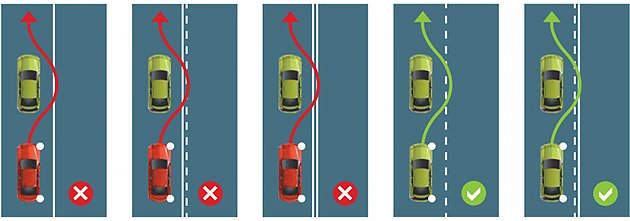
U-turns
This rule can be tricky to remember as it varies depending on whether there are traffic lights or not and how many lanes there are in each direction. But here’s what you need to know, according to regulation 31 of the Code.
At an intersection with traffic lights, you can only make a U-turn where it’s indicated that U-turns are permitted.
At an intersection without traffic lights, you can make a U-turn unless it’s indicated that U-turns are not permitted.
On roads with only one lane in each direction, you can make a U-turn unless it’s indicated that it’s not permitted.
On a road with two or more lanes in one direction, you are allowed to make a U-turn unless it’s indicated that it’s not permitted, but you must turn from the lane closest to the centre of the road.
When it comes to U-turns generally, regulation 32 says that before you start, you must wait until you have a clear view of any approaching traffic and can do it safely, without interfering with the passage of other traffic. You must also give way to all pedestrians and vehicles.
Parking across a footpath
Whether it’s a shared path, bicycle path, a separated footpath or just a footpath, regulation 166 says that drivers may not stop on a path or obstruct access to or from a path. The only exceptions are if you’re dropping off or picking up passengers, or when you have stopped in a parking bay where permitted. The same goes for someone’s driveway or other access way at the point where the path forms part of the driveway or other access way.
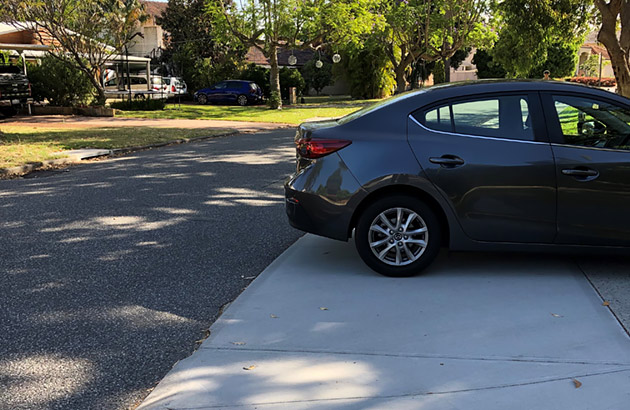
Flattop road hump vs wombat crossings
The traffic management device shown below is a flat-top road hump with what are referred to as ‘piano markings’ along its edges. These markings are used to help drivers recognise the presence of the road hump.
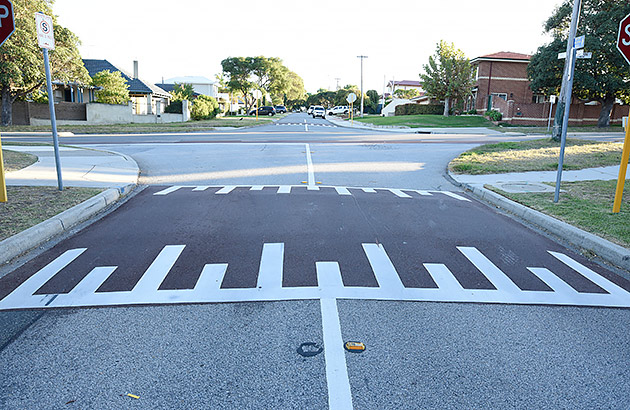
This type of road hump is used to slow vehicle speeds, but drivers are not legally required to stop for pedestrians, cyclists or others crossing at these locations. It’s not intended for use at points on the road which are designed for pedestrians to cross.
The image below is a ‘wombat crossing’ - a pedestrian crossing that is on a road hump marked with a zebra crossing. In this example, the wombat crossing is also painted with piano markings.
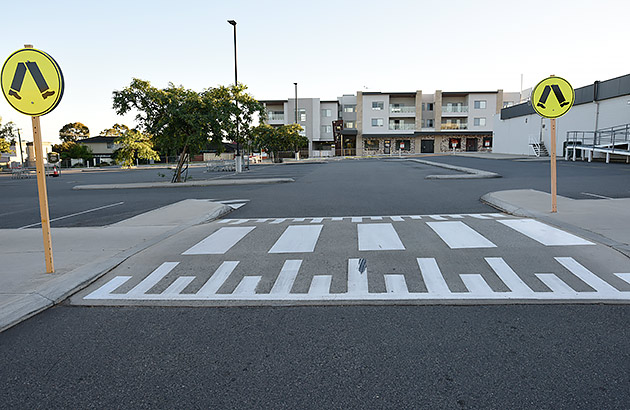
Drivers must give way to pedestrians at wombat crossings in the same way they would at a level pedestrian crossing.
The raised surface and markings of a wombat crossing improve its visibility and compel motorists to lower their speed when approaching. Wombat crossings are most often used in low speed environments (typically 40 km/h or less) where the volume of traffic and pedestrians are higher, such as shopping areas.
At all pedestrian crossings, including wombat crossings, it’s also important to remember that cyclists are not permitted to ride across. They must dismount and walk their bicycle across. The same applies to children’s crossings and other marked foot crossings. The exception is where there is a bicycle signal and the signal light is green.
Motorcyclists riding between cars
It is legal in WA for motorcyclists to ride between vehicles travelling in the same direction, but there are many exceptions to the rule.
Known as Lane filtering, this is a manoeuvre where a motorcyclist rides at a speed of no more than 30km/h between two lanes of stationary or slow-moving traffic that is in separate but adjacent marked lanes, all travelling in the same direction.

While lane filtering, the motorcyclist can ride over continuous white lines separating, lanes of traffic and then stop at the front of an intersection, if it’s safe to do so.
The situations in which lane filtering is not allowed, include (but are not limited to):
- Where the motorcyclist is travelling above 30km/h.
- In a school zone or shared zone.
- In an area or zone where the speed limit is 40km/h or below.
- Approaching or on a pedestrian or children’s crossing.
- Between one or more heavy vehicles.
- When the vehicles the rider is between are merging.
Using a mini roundabout
While mini roundabouts are subject to the same regulations as other roundabouts, their small size means that some rules work a bit differently in practice to full-size roundabouts.
At a regular roundabout, if practicable, you must signal left when exiting. But on a mini roundabout, where the distance between one exit and the next is very short, this generally isn’t practicable. All other signalling rules do however apply.
So if you’re leaving a mini roundabout at the first exit and it’s less than halfway around, indicate a left turn before you enter. If continuing straight ahead or reasonably straight ahead along the road on which you entered, you don’t need to indicate as you enter the roundabout. If you’re turning right - so exiting after the halfway point - indicate a right turn before you enter the roundabout.
A driver entering a roundabout must give way to vehicles within the roundabout. On larger roundabouts, this typically means giving way to the right. Mini roundabouts, on the other hand, may require you to give way to the left if a vehicle approaching from a road to your left enters before you.
When approaching a mini roundabout, be prepared to give way to vehicles using any of the other approaches, as all entries are in close proximity to each other. As at all roundabouts, use caution when entering, even if you have right of way, in case another driver has not seen you or falsely believes that they have right of way.

Driving around oversize vehicles
Oversize vehicles transporting large loads on our roads are often accompanied by Heavy Vehicle Pilot vehicles (amber flashing lights) or Traffic Escort Warden vehicles (red and blue flashing lights). Oversize vehicles are required to have a certain number of pilot and escort vehicles depending on the length and width of the vehicle and load, location and time of day.
The role of these vehicles is to ensure the safe movement of oversize loads, providing advance warning to motorists, managing traffic around the load and giving directions to the driver of the oversize vehicle.
It’s important to remember that these pilots and escorts have the same powers as WA Police to direct you around the vehicle, so ensure you follow their directions.
If these vehicles are coming towards you, slow down and move to the left. Many oversize vehicles need to travel closer to the middle of the road so that any wide loads don’t collide with power lines or other roadside objects, so you may need to pull off the road completely. Wait until the last pilot or escort vehicle following the oversize load has passed you and the way is clear before indicating to re-enter the road.
If you’re following behind an oversize vehicle, the drivers of the pilot or escort vehicles may direct you when it’s safe to overtake. In some instances, the whole convoy may pull over and signal for you to pass.
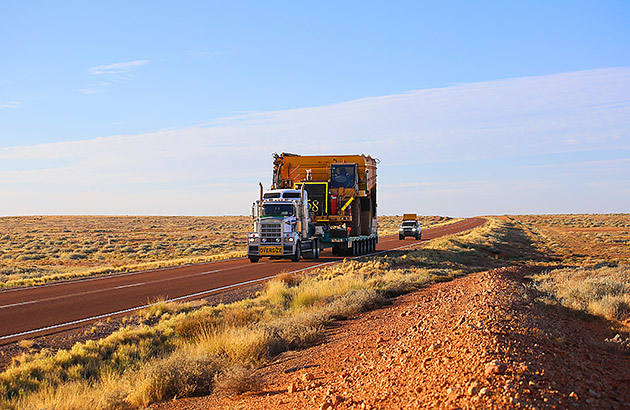
Bicycle racks obscuring car number plates
Ensuring the number plates on both the front and rear of a vehicle are visible when it is in use, is the responsibility of every vehicle owner.
But there can be some confusion about the placement of bicycle racks on the rear of vehicles where they obscure the registration plate.
Regulation 120 of the Road Traffic (Vehicles) Regulations 2014 states that bicycle racks are exempted from this rule, however the intent of Regulation 119 is to ensure that vehicles must at all times have a number plate in a conspicuous place on the front and rear of the vehicle where the characters are clearly legible (and not, for example, obstructed by a bicycle rack). So regulation 119 suggests that bicycle racks are only exempted from Regulation 120 because they are supposed to be covered by Regulation 119.
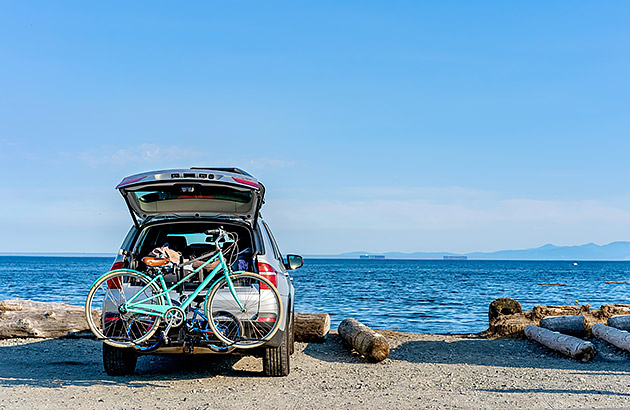
To ensure you’re not fined, if your bicycle racks do obscure you car’s number plate, fit auxiliary plates.
The Department of Transport provides auxiliary plates for drivers to purchase via a DoTDirect account. An auxiliary plate will display the same characters as the number plate issued for the vehicle.
Towing speed limits
In WA there is a maximum speed limit of 100km/h for vehicles when towing any type of trailer, including caravans, boats, box and other trailers.
WA the only state or territory that requires vehicles with trailers to travel at a slower speed than the posted maximum no matter what you tow.
Rules vary from state to state. For example, in Victoria and Queensland there is no towing speed limit. In NSW, if the total weight of the fully loaded car and trailer exceeds 4.5 tonnes, then you can’t legally drive over 100km/h.
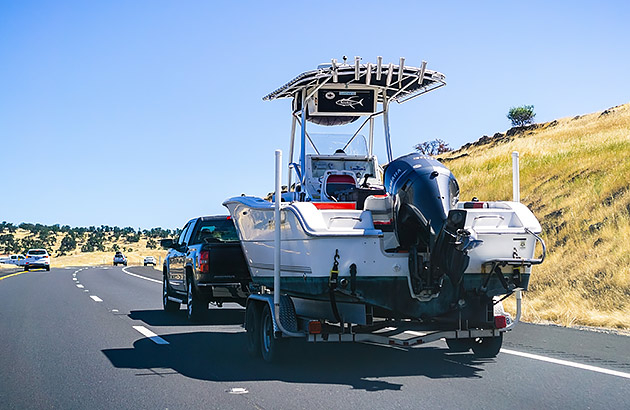
It also pays to be aware that some vehicle manufacturers also place limits on the speed their vehicles can travel while towing, Ford’s Ranger, Everest and F-150, for example, have a manufacturer recommend a maximum speed of 100km/h. Most Subarus that can tow are limited to 80km/h when towing.
Travelling with your dog in the car
In WA, a dog is not permitted to ride on the driver’s lap and must not prevent the driver from being in control of the vehicle. There is no specific rule that makes it unlawful for them to ride in the front passenger seat. There is also no road rule that requires them to be restrained. However if your dog is not restrained and transported in a way that could ‘cause harm’, you could be in breach of the Animal Welfare Act 2022.
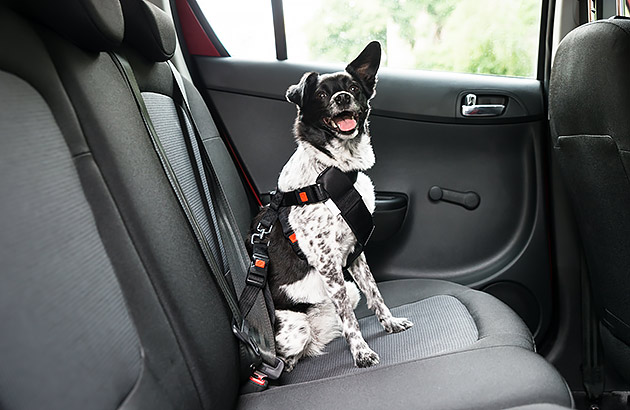
Get going with RAC Go Change your backseat driver for a better one. Download RAC Go, the app designed to help you monitor and improve your driving behaviour with fun challenges. And it’s free!
